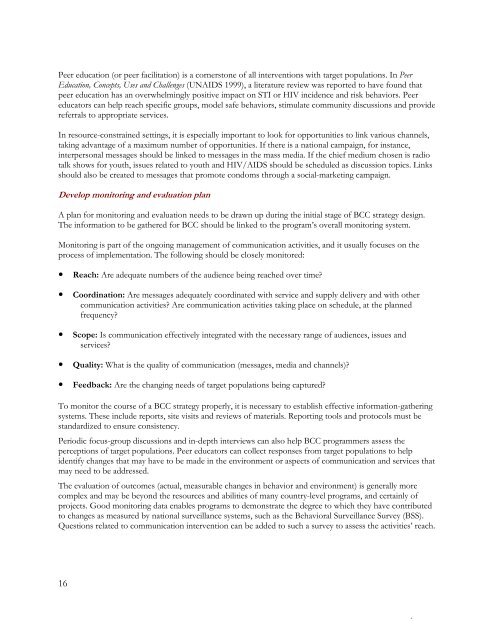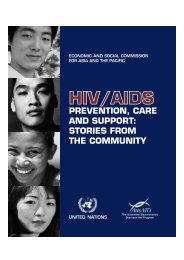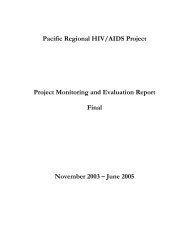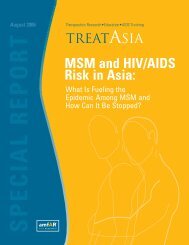Behavior Change Communication (BCC) for HIV/AIDS - hivpolicy.org
Behavior Change Communication (BCC) for HIV/AIDS - hivpolicy.org
Behavior Change Communication (BCC) for HIV/AIDS - hivpolicy.org
Create successful ePaper yourself
Turn your PDF publications into a flip-book with our unique Google optimized e-Paper software.
Peer education (or peer facilitation) is a cornerstone of all interventions with target populations. In Peer<br />
Education, Concepts, Uses and Challenges (UN<strong>AIDS</strong> 1999), a literature review was reported to have found that<br />
peer education has an overwhelmingly positive impact on STI or <strong>HIV</strong> incidence and risk behaviors. Peer<br />
educators can help reach specific groups, model safe behaviors, stimulate community discussions and provide<br />
referrals to appropriate services.<br />
In resource-constrained settings, it is especially important to look <strong>for</strong> opportunities to link various channels,<br />
taking advantage of a maximum number of opportunities. If there is a national campaign, <strong>for</strong> instance,<br />
interpersonal messages should be linked to messages in the mass media. If the chief medium chosen is radio<br />
talk shows <strong>for</strong> youth, issues related to youth and <strong>HIV</strong>/<strong>AIDS</strong> should be scheduled as discussion topics. Links<br />
should also be created to messages that promote condoms through a social-marketing campaign.<br />
Develop monitoring and evaluation plan<br />
A plan <strong>for</strong> monitoring and evaluation needs to be drawn up during the initial stage of <strong>BCC</strong> strategy design.<br />
The in<strong>for</strong>mation to be gathered <strong>for</strong> <strong>BCC</strong> should be linked to the program’s overall monitoring system.<br />
Monitoring is part of the ongoing management of communication activities, and it usually focuses on the<br />
process of implementation. The following should be closely monitored:<br />
• Reach: Are adequate numbers of the audience being reached over time?<br />
• Coordination: Are messages adequately coordinated with service and supply delivery and with other<br />
communication activities? Are communication activities taking place on schedule, at the planned<br />
frequency?<br />
• Scope: Is communication effectively integrated with the necessary range of audiences, issues and<br />
services?<br />
• Quality: What is the quality of communication (messages, media and channels)?<br />
• Feedback: Are the changing needs of target populations being captured?<br />
To monitor the course of a <strong>BCC</strong> strategy properly, it is necessary to establish effective in<strong>for</strong>mation-gathering<br />
systems. These include reports, site visits and reviews of materials. Reporting tools and protocols must be<br />
standardized to ensure consistency.<br />
Periodic focus-group discussions and in-depth interviews can also help <strong>BCC</strong> programmers assess the<br />
perceptions of target populations. Peer educators can collect responses from target populations to help<br />
identify changes that may have to be made in the environment or aspects of communication and services that<br />
may need to be addressed.<br />
The evaluation of outcomes (actual, measurable changes in behavior and environment) is generally more<br />
complex and may be beyond the resources and abilities of many country-level programs, and certainly of<br />
projects. Good monitoring data enables programs to demonstrate the degree to which they have contributed<br />
to changes as measured by national surveillance systems, such as the <strong>Behavior</strong>al Surveillance Survey (BSS).<br />
Questions related to communication intervention can be added to such a survey to assess the activities’ reach.<br />
16











